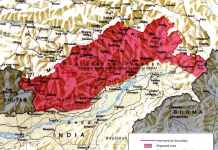Russia announced on April 18 that as part of the Pacific Fleet’s extensive combat preparation training, its strategic nuclear-powered submarine cruisers and multipurpose nuclear submarines have deployed to the Pacific Ocean.
The Russian Ministry of Defense (MoD) said in a statement, “As part of the Pacific Fleet’s sudden combat readiness inspection being carried out by the decision of Supreme Commander-in-Chief of the Russian Armed Forces, Vladimir Putin, strategic nuclear-powered missile-carrying submarine cruisers and multipurpose nuclear submarines have deployed to the designated areas in the Pacific waters.”
Oceanic minesweepers from a formation of naval ships to protect the water area in Russia’s northeast supported the departure of nuclear-powered subs from their naval bases, leading them behind their sweeps, said a TASS report.
According to the report, smoke screens concealed the nuclear-powered submarines’ departure. In addition, anti-saboteur personnel traveling on fast-moving vessels ensure their safe passage. All navies withhold information about the sailing of their submarines for security purposes.
However, the report failed to name the nuclear submarines deployed for the extensive Pacific drills. The MoD’s announcement comes a day after Russian President Vladimir Putin hailed the military’s preparedness during massive naval exercises that have involved the entire Russian Pacific Fleet.
Since the end of World War Two, Japan and Moscow have been engaged in a territorial dispute over islands in the North Pacific which is why Japan snapped at Russia with an angry note.
Japan’s cabinet secretary Hirokazu Matsuno stated on April 17 that Moscow had received a protest letter from Tokyo regarding its military drills near the major northern island of Japan, Hokkaido.
In response, Russia dismissed Japanese criticism of the Pacific Fleet’s military drills, arguing that while focusing on Ukraine, the country needed to be vigilant against several other regional dangers.

“Our environment is very turbulent on many fronts. It’s fraught with regional conflict situations,” Kremlin spokesman Dmitry Peskov told reporters. “We are all aware of the geography of these regional conflicts.”
Despite an intense conflict in Ukraine, the Russian military has regularly hosted large-scale military drills. Moreover, Russia’s military cooperation with China has recently seen an uptick in the Pacific. The Pacific Fleet drills started just before Chinese Defense Minister Gen. Li Shangfu arrived in Russia on April 16 and met with President Putin.
In September 2022, China and Russia launched joint naval drills in the Pacific, with the destroyers and other warships of either side conducting live fire training and helicopter deck flights. At the time, as part of what the Russian military refers to as joint patrols, the warship crews also practiced joint tactical maneuvering and ship-to-ship communications.
As for Russia’s submarines, the Russian Navy boasts the most diverse submarine fleets in the world. Moscow sees some of these submarines’ capability to deploy ballistic missiles with nuclear warheads as essential to its strategic deterrence.
Since the dissolution of the Soviet Union in 1991, the nation has been assiduously developing its submarine fleet. Moscow has created a large number of submarines, many of which can reach the most critical targets in the United States and continental Europe.
Russia’s Pacific Military Russia’s Drills
The units of the Russian Pacific Fleet were placed on high alert on April 14 as part of an unexpected combat readiness review. According to reports, the navy sailors trained to thwart an enemy’s entry into the Sea of Okhotsk, repel the arrival of an enemy force on the Island of Sakhalin, and protect the southern Kuril Islands.

Some Aerospace Forces units were also included in the spontaneous combat readiness examination led by Russian Navy Commander-in-Chief Nikolay Yevmenov.
For instance, Tu-142 anti-submarine warfare aircraft from the Pacific Fleet hunted down a notional enemy’s submarines during the surprise combat Pacific Fleet inspection. In addition, two Russian T-95MS strategic missile bombers flew over the Bering and Okhotsk Seas on a scheduled mission to check their combat readiness.
The broad exercises are intended to increase the Russian forces’ preparedness for “repelling a potential enemy’s aggression from oceanic and maritime directions.” Strategic nuclear-powered submarine activities will be a crucial component of the exercise.
The Pacific Fleet’s surprise combat readiness inspection will involve almost 25,000 people, 167 combat ships, and support vessels, including 12 submarines, 89 aircraft, and helicopters, as Defense Minister Shoigu reported.
- Contact the author at sakshi.tiwari9555 (at) gmail.com
- Follow EurAsian Times on Google News




